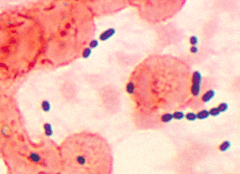Enterococcus facts for kids
Quick facts for kids Enterococcus |
|
|---|---|
 |
|
| Enterococcus sp. infection in lung tissue | |
| Scientific classification | |
| Kingdom: | |
| Division: | |
| Class: | |
| Order: | |
| Family: |
Enterococcaceae
|
| Genus: |
Enterococcus
|
Enterococcus is a type of tiny living thing called bacteria. These bacteria are part of a larger group known as lactic acid bacteria. They are very small, like tiny balls, and often appear in pairs or short chains. You can find them naturally living in the intestines of humans and animals.
Two common types of Enterococcus bacteria live in the human gut: E. faecalis (which makes up about 90-95% of them) and E. faecium (about 5-10%).
Contents
What are Enterococci?
Enterococci are known as "Gram-positive cocci". This means they look like tiny spheres under a microscope and react in a certain way to a special test called a Gram stain. They often grow in pairs or short chains, which makes them look a bit like another type of bacteria called Streptococcus.
How Enterococci Live
These bacteria are "facultative anaerobic organisms". This is a fancy way of saying they are very flexible! They can live and grow well whether there is oxygen around or not. This helps them survive in many different parts of the body.
How They Are Classified
For a long time, until 1984, scientists thought Enterococcus bacteria were just a special kind of Streptococcus. But then, new ways of studying their DNA showed that they were different enough to be put into their own separate group, or genus.
Enterococcus and Your Health
While many Enterococcus bacteria live harmlessly in our bodies, some types can cause infections if they get into the wrong places or if a person's immune system is weak.
Common Infections
Some common infections caused by Enterococcus include:
- Urinary tract infections (UTIs), which affect the bladder or kidneys.
- Bacterial endocarditis, which is an infection of the heart's inner lining.
- Diverticulitis, an infection in the digestive system.
- Meningitis, a serious infection of the membranes around the brain and spinal cord.
Treating Infections
Doctors can often treat these infections with antibiotics like ampicillin, penicillin, and vancomycin. However, a big challenge with Enterococcus is that many types are naturally resistant to some common antibiotics. This means certain medicines might not work against them. Scientists are always working to find new ways to fight these tough bacteria.
See also
 In Spanish: Enterococcus para niños
In Spanish: Enterococcus para niños

